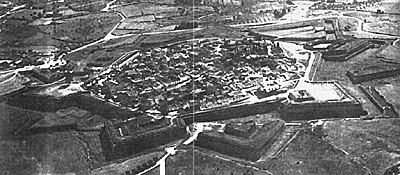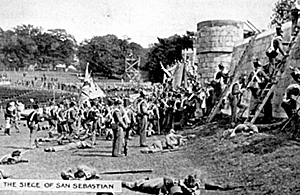"Alma Ate Almeida"
The Portuguese Fortress of Almeida:
A Personal Guide to A Most Perfect Work
by Richard 'Rifleman' Rutherford-Moore
| |
Almeida stands high above the surrounding countryside, both in excellent condition and in a spectacular location, built to dominate and impress, protecting both economic and military interests from Spanish invasion. Guarding the frontier, the new fortress replaced the old mediaeval one from 1641, the designer (Antoine Deville, a Frenchman) building into the defences all the fashionable niceties of enfilade, oblique and direct fire and the latest methods of killing the enemy besiegers en masse if they were to try and assault it.
You can still get lost today wandering around in its ditches, even in daylight. Fort Conception, to the southeast, is an independent work nearby begun around 1730, which guarded the old road from Spain. This was blown up by the Allies in 1810 during the Peninsula War, but remains another fine example of frontier fortress. The 'breaches' there are still practical, and were never repaired, the route of the new road going through Vilar Formoso. The explosion of August 1810, when the fortress was manned by Portuguese troops of Wellington's Army, and a French shell set off loose powder which in turn ignited the magazine in the citadel, was second only in power to the almost nuclear blast in Corunna in January 1809. A few hundred powder barrels there were exploded three miles from the town to save them falling into the hands of the French, but prior to the laying of the fuses nobody thought to look into the store next door, where 4000 barrels of gunpowder were stored! The resulting bang was heard in Southampton; left a monumental crater with a towering mushroom cloud, caused a tidal wave in the harbour which sank or damaged shipping, swept off roofs and broke windows, altering the topography of the town, and killing hundreds of spectators that went to watch the display (and probably led to the invention of the eartrumpet).
The town of Almeida is a very friendly place, and can be used as a base for exploration to Fuentes D'Onoro, Freinada, the Coa River, and Ciudad Rodrigo. Many of its inhabitants are happy to tell you stories of their houses and their former occupants (even when the listener is English and dressed in his rifleman's uniform) and sometimes show you a forgotten item from Napoleonic times; a teacup, a sword, or a letter written by an officer. There is a pace of life, but molluscs have no difficulty keeping up with it. Almeida is a place where you can wander around at will, and visualise with ease the daily workings of a period fortress, without the fatal distractions you find at similar period fortresses, Ciudad Rodrigo or The Other Place.
During the storming of Ciudad Rodrigo in January 1812, John Beresford, the son of Marshal William Beresford, a British officer who commanded the Portuguese troops in Wellington's Army, was mortally wounded in the Great Breach. His Portuguese soldiers wrapped him up, made a stretcher and carried him back through the snow towards Portugal, pleading with him to stay alive until they reached the frontier, and not to die in Spain. Every mile they prayed for him, but never stopped moving; he lasted until Almeida, where he died. The prayers, "Alma ate Almeida" "Save your soul for Almeida" became a fighting proverb for future brave soldier generations to this day.
More Fortress of Almeida
|


 Little was left standing above the height of the foundations of the citadel of Almeida and adjoining church, blocks of masonry even raining down onto the heads of the French besiegers. All the town roofs on the same level were sheared off; remarkably leaving houses that were low in the town untouched save for broken windows. Over 500 soldiers of the garrison were killed in this blast; the luckiest being the sentry who saw or heard the initial rumble before the main magazine blew and leapt into an open bread oven, saving his life although the bakery was subsequently flattened in the explosion.
Little was left standing above the height of the foundations of the citadel of Almeida and adjoining church, blocks of masonry even raining down onto the heads of the French besiegers. All the town roofs on the same level were sheared off; remarkably leaving houses that were low in the town untouched save for broken windows. Over 500 soldiers of the garrison were killed in this blast; the luckiest being the sentry who saw or heard the initial rumble before the main magazine blew and leapt into an open bread oven, saving his life although the bakery was subsequently flattened in the explosion.